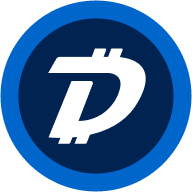
Cours du DigiByte

Infos sur le marché du DigiByte
Cap. boursière = offre en circulation × dernier cours

Calculateur DGB


Prix DigiByte aujourd’hui en USD
Conversions de DigiByte populaires
| 1 DGB en USD | 0,010230 $ |
| 1 DGB en PHP | 0,57998 ₱ |
| 1 DGB en EUR | 0,0089955 € |
| 1 DGB en IDR | 172,51 Rp |
| 1 DGB en GBP | 0,0077118 £ |
| 1 DGB en CAD | 0,014160 $ |
| 1 DGB en AED | 0,037575 AED |
| 1 DGB en VND | 264,82 ₫ |
À propos du DigiByte (DGB)
- Site web officiel
- Livre blanc
- Github
- Explorateur de blocs
FAQ DigiByte
DigiByte est une plateforme blockchain open-source et décentralisée qui fonctionne sur le modèle UTXO (Unspent Transaction Output) afin d'améliorer la confidentialité et la sécurité. Le projet apporte diverses améliorations à la base de code Bitcoin, notamment un temps de création des blocs plus rapide, une plus grande évolutivité et une vitesse de transaction accrue. Il utilise également une combinaison unique de cinq algorithmes de Proof of Work (PoW) différents pour garantir la décentralisation et la sécurité du réseau. Le token natif de l'écosystème DigiByte s'appelle DGB et peut être utilisé pour les transactions numériques, comme réserve de valeur et pour participer au réseau DigiByte.
DigiByte offre plusieurs avantages. Tout d'abord, DigiByte a un temps de création de bloc rapide de seulement 15 secondes, ce qui permet des confirmations de transaction rapides et une expérience utilisateur plus efficace. Deuxièmement, la plateforme utilise plusieurs algorithmes PoW, ce qui renforce la sécurité contre les attaques potentielles et garantit un réseau plus décentralisé. En outre, DigiByte dispose d'un grand nombre de tokens, avec un plafond total de 21 milliards, ce qui le rend adapté aux microtransactions et fournit une grande liquidité au sein de l'écosystème.
Achetez facilement des jetons DGB sur la plateforme de cryptomonnaies OKX. Les paires de trading disponibles dans le terminal de trading au comptant OKX incluentDGB/USDT.
Vous pouvez également échanger vos cryptomonnaies existantes, y comprisXRP (XRP),Cardano (ADA),Solana ( SOL)etChainlink (LINK), pour la direction générale B sans frais et sans glissement de prix en utilisantOKX Convert.
Avis de non-responsabilité
Calculateur DGB



































Données sociales